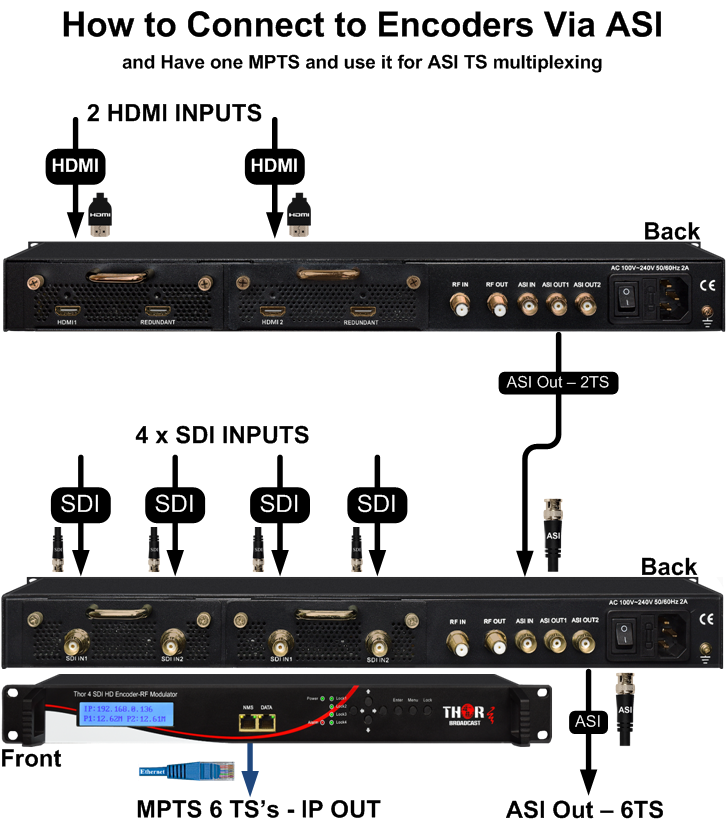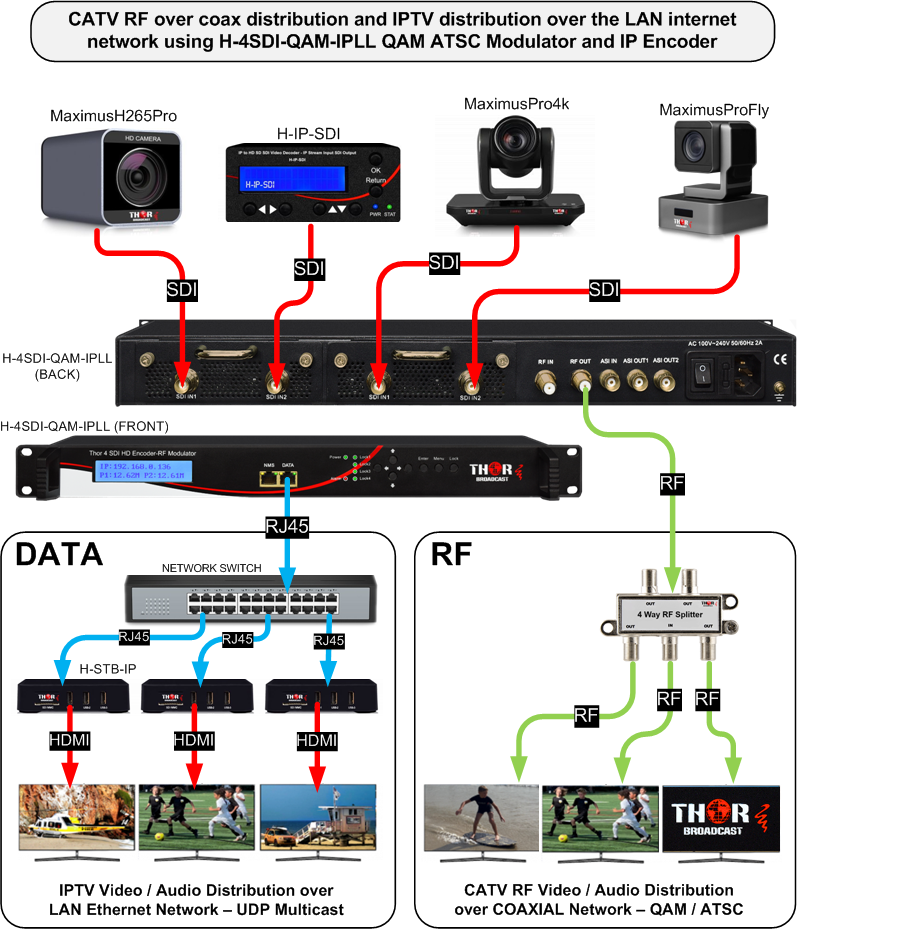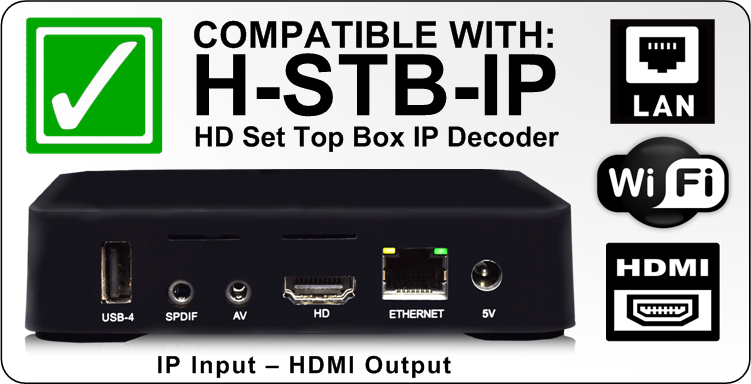|
How can I help you?
|
|
i am trying to design a system that can convert 1920x1080 SDI signal to be broadcast over an existing CATV distribution system in a school and possibly using the existing coax cable to upgrade an area to HD over coax to the TV's
|
|
i need the signal at 2 different locations that we are planning to connect together with fiber
|
|
basically we have a football stadium press box where we will have live cameras outputting the SDI signal and we want that signal to go back to the control room in another building via fiber
|
|
These units would be good for doing SDI to RF https://thorbroadcast.com/product/1-4-sdi-to-qam-modulators-and-iptv-streaming-encoders.html/4
|
|
after it gets back to the control room we want to distribute it into the school and back to the press box for the replay TV's
|
|
ok
|
|
Well we can do the SDI over Fiber if you need that, https://thorbroadcast.com/products/sdi-1
|
|
once the signal is converted to CATV RF, it gets more complicated then just putting SDI on Fiber.
|
|
i was afraid the distance to the press box would be too far to send a digital signal over coax
|
|
the SDI modulators can convert the source to CATV channels, which then you'd need RF over Fiber gear like this https://thorbroadcast.com/products/cable-tv-catv-rf-45-900mhz
|
|
Is your fiber multimode or singlemode?
|
|
and what's the approximate distance?
|
|
multimode and its around 700ft
|
|
Well all of the SDI over Fiber gear is fine with that; those converters work to about a couple thousand feet on multimode, and about 20km on single mode; so you see the massive difference between the 2 kinds of fibers.
|
|
RF can not go on Multimode, flat out won't work
|
|
well, we haven't ran the fiber yet. So, we could go single mode if necessary
|
|
is the fiber necessary at that distance? how far can digital TV signal run instead of RF?
|
|
Yea, Multimode isn't useful in a lot of AV applications
|
|
Digital TV is still RF
|
|
whether its ATSC or QAM; still an RF wave
|
|
so, we'll experience the same DB signal losses like RF?
|
|
no RF is a completely different animal versus a digital video signal like an SDI camera
|
|
sorry, i haven't done much of this before. I am very familiar with CATV distribution but not as far as digital goes
|
|
I know the signal degrades quickly on an analog system. I don't know about the digital
|
|
same difference when it's on fiber
|
|
but analog is pretty much extinct for the most part, we only sell digital modulators these days
|
|
Thats why we want to keep the signal RF in the main school because of the infrastructure
|
|
the press box is small and we can just send a digital signal in there and we are planning on upgrading all of the TVs
|
|
but the distance is a problem. I don't know if we get get a digital signal that far on a coax or if we need to use a fiber and send the SDI signal from the control room over to the press box and then use one of your converters in there to change it over to a digital TV signal
|
|
So sending SDI over Fiber is pretty simple
|
|
converting SDI to RF and then sending that over fiber gets a little tricky.
|
|
How many SDI sources do you have?
|
|
he wants to have up to 4
|
|
one or two could be HDMI signals from like a cable tv box
|
|
so he can broadcast a TV channel
|
|
i think they could technically do it with 1 SDI signal from their control room. We will have several cameras coming back to their control room that they already have equipment for that will output the SDI signal that we need to broadcast
|
| https://thorbroadcast.com/ is sharing a file with you. image.png - (Size:809.98 KB) |
|
We offer these in 1, 2, and 4 SDI inputs ---- they will take your SDI feed and convert to CATV
|
|
If you already have pieces like this that convert SDI to RF, and you just want to send the RF from the booth back to the school, then you can just use a compact RF over Fiber kit.
|
|
does it take anything special to split an SDI signal?
|
|
I honestly don't know, people don't necessarily split those signals, usually, they use switchers, converters, encoders etc.
|
|
I would think it would just need a splitter on the RG cable
|
|
where is a good place to buy your equipment from? Do you sell direct or should i go through a distributor?
|
|
We do sell direct, and also through countless resellers and distributors
|
|
Anixter, Markertek, B&H, AMT, Toner Cable, HDTV supply etc
|
|
i sent in a reseller request about a week ago but i haven't heard anything back.
|
|
after we close down this Chat, I'll send you a copy of the transcript, and the Reseller Agreement. We'll get you signed up
|
|
ok, thank you.
|
|
one more question
|
|
sure
|
|
we have a single location that is in the visitor's concession stand that is about 1k ft away that has MM fiber to it and also an RG cable to it. We will need to get this digital TV signal over there.
|
|
CATV can only go on Singlemode Fiber; so if you want to send the visitor's concession stand the same TV signal, you'll need to install single-mode fiber to there
|
|
i was afraid you were going to say that haha
|
|
Television, regardless of analog or digital, can NOT go on multimode fiber.
|
|
no company in the world makes gear that will solve your issue; we get this a lot!
|
|
can it run on the RG cable? we are using that now
|
|
not in 1080 right now of course
|
|
with proper amplification you could probably do that; but then you're going to need a power supply along the way.
|
|
so if the conduit goes under the football field, then I bet it won't work
|
|
right now we have it on like channel 14 being broadcast
|
|
i'm not sure of the quality right now
|
|
That information doesn't really help; it doesn't matter if its 720; 480 or 1080; getting the digital signal there on RG6 would be difficult, but maybe a couple of these https://thorbroadcast.com/product/distribution-amplifier-30db-54-1000mhz-coax-catv-qam-atsc-analog-rf.html
|
|
what about IPTV streaming? could we send the signal over the network? do you sell components for that?
|
|
sorry for all of the stupid questions ...
|
|
Yes we do, a lot of our IPTV equipment is here https://thorbroadcast.com/products/pro-dvb-encoders
|
|
I knew this was going to be a little complicated haha. I need to learn more so that i can convert more schools to digital away from the analog.
|
|
Yeah its a small learning curve
|
|
If you have a design drawing that would help; we can let you know exactly what you'd need to get the job done
|
|
i don't ... but i could possibly make something.
|
|
Yeah, I mean considering you want to send the signal from the booth to the school, then back to the booth, plus add in the visitor bench, I would encourage only singlemode fiber; then the components can inserted in between the fiber infrastructure
|
|
I'll have cameras in the press box sending SDI signal back to the booth. They will then do whatever with the signal and send output of SDI to me for me to distribute in the school and back to the press box TV's
|
|
and to the visitor concession TV
|
|
they want me to run the fiber for their cameras and for my distribution system
|
|
I'll look at some more of your components and try to learn some more and ask some more questions later. Thank you for your assistance today.
|

 ES
ES





















